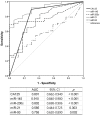Serum exosomal miRNA-145 and miRNA-200c as promising biomarkers for preoperative diagnosis of ovarian carcinomas
- PMID: 31205555
- PMCID: PMC6548168
- DOI: 10.7150/jca.30231
Serum exosomal miRNA-145 and miRNA-200c as promising biomarkers for preoperative diagnosis of ovarian carcinomas
Abstract
Background: Exosomes are extracellular microvesicles that are released by most cells and widely distributed in various body fluids. Malignant cells secrete large amounts of exosomes containing various molecular constituents reflecting the originating tumor. We investigated the difference in microRNA (miRNA) expression in serum exosomes from the patients with benign, borderline and malignant ovarian masses to assess the diagnostic relevance of serum exosomal miRNAs as biomarkers for preoperative diagnosis of ovarian carcinoma. Methods: A total of 68 cases of ovarian masses were enrolled, comprising benign ovarian cysts (benign; n=10), borderline ovarian tumors (BOT, n=10), high-grade serous ovarian carcinomas (HGSOC, n=39) and non-HGSOCs (n=9). Exosomal RNA was extracted from the serum, and expression levels of seven miRNAs (miRNA-21, -93, -141, -145, -200a, -200b and -200c), which were reportedly dysregulated in serous ovarian cancer in previous studies, were quantified by real-time PCR, and compared between the four groups. Results: MiR-93, -145, and -200c, showed significantly higher expression in serum exosomes of the cancer group (HGSOC and non-HGSOC) than of the non-cancer group (benign and BOT; all p<0.05). The remaining three miRs (miR-141, -200a, and -200b) were expressed at extremely low levels, and not appropriate as serological biomarkers. To test discrimination of cancer from non-cancer, the area under the receiver operating characteristic curves determined for cancer antigen 125 (CA125), miR-145, miR-200c, miR-21, and miR-93 were 0.801 (p<0.001), 0.910 (p<0.001), 0.802 (p<0.001), 0.585 (p=0.303), and 0.755 (p=0.002), respectively. MiR-145 showed superior sensitivity (91.6%), and miR-200c showed superior specificity (90.0%), compared with CA125. Conclusion: Expression of exosomal miR-93, miR-145 and miR-200c was significantly elevated in the serum of ovarian cancer patients. Serum exosomal miR-145 in particular appeared to be the most promising biomarker for preoperative diagnosis of ovarian cancer.
Keywords: biomarker; exosome; microRNA; ovarian cancer; serum.
Conflict of interest statement
Competing Interests: The authors have declared that no competing interest exists.
Figures



Similar articles
-
Diagnostic and prognostic relevance of circulating exosomal miR-373, miR-200a, miR-200b and miR-200c in patients with epithelial ovarian cancer.Oncotarget. 2016 Mar 29;7(13):16923-35. doi: 10.18632/oncotarget.7850. Oncotarget. 2016. PMID: 26943577 Free PMC article.
-
Serum exosomal miR-200c is a potential diagnostic biomarker for breast cancer.Biomarkers. 2024 Nov;29(7):419-426. doi: 10.1080/1354750X.2024.2406520. Epub 2024 Oct 11. Biomarkers. 2024. PMID: 39317236
-
Exosomal miR-1290 is a potential biomarker of high-grade serous ovarian carcinoma and can discriminate patients from those with malignancies of other histological types.J Ovarian Res. 2018 Sep 15;11(1):81. doi: 10.1186/s13048-018-0458-0. J Ovarian Res. 2018. PMID: 30219071 Free PMC article.
-
miRNA-200a/c as potential biomarker in epithelial ovarian cancer (EOC): evidence based on miRNA meta-signature and clinical investigations.Oncotarget. 2016 Dec 6;7(49):81621-81633. doi: 10.18632/oncotarget.13154. Oncotarget. 2016. PMID: 27835595 Free PMC article. Review.
-
Non-Exosomal and Exosome-Derived miRNAs as Promising Biomarkers in Canine Mammary Cancer.Life (Basel). 2022 Apr 1;12(4):524. doi: 10.3390/life12040524. Life (Basel). 2022. PMID: 35455015 Free PMC article. Review.
Cited by
-
Exosomal Cargo in Ovarian Cancer Dissemination.Curr Issues Mol Biol. 2023 Dec 7;45(12):9851-9867. doi: 10.3390/cimb45120615. Curr Issues Mol Biol. 2023. PMID: 38132461 Free PMC article. Review.
-
Deregulated miRNA clusters in ovarian cancer: Imperative implications in personalized medicine.Genes Dis. 2022 Mar 1;9(6):1443-1465. doi: 10.1016/j.gendis.2021.12.026. eCollection 2022 Nov. Genes Dis. 2022. PMID: 36157483 Free PMC article. Review.
-
[MicroRNA-200c-3p inhibits proliferation of nephroblastoma cells by targeting CCNE2].Nan Fang Yi Ke Da Xue Xue Bao. 2020 Sep 30;40(9):1246-1252. doi: 10.12122/j.issn.1673-4254.2020.09.04. Nan Fang Yi Ke Da Xue Xue Bao. 2020. PMID: 32990223 Free PMC article. Chinese.
-
Revisiting the miR-200 Family: A Clan of Five Siblings with Essential Roles in Development and Disease.Biomolecules. 2022 Jun 3;12(6):781. doi: 10.3390/biom12060781. Biomolecules. 2022. PMID: 35740906 Free PMC article. Review.
-
Identification of serum miR-1246 and miR-150-5p as novel diagnostic biomarkers for high-grade serous ovarian cancer.Sci Rep. 2023 Nov 7;13(1):19287. doi: 10.1038/s41598-023-45317-7. Sci Rep. 2023. PMID: 37935712 Free PMC article.
References
-
- Siegel RL, Miller KD, Jemal A. Cancer statistics, 2018. CA Cancer J Clin. 2018;68:7–30. - PubMed
-
- Karlsen MA, Sandhu N, Hogdall C, Christensen IJ, Nedergaard L, Lundvall L. et al. Evaluation of HE4, CA125, risk of ovarian malignancy algorithm (ROMA) and risk of malignancy index (RMI) as diagnostic tools of epithelial ovarian cancer in patients with a pelvic mass. Gynecol Oncol. 2012;127:379–83. - PubMed
-
- Bartel DP. MicroRNAs: genomics, biogenesis, mechanism, and function. Cell. 2004;116:281–97. - PubMed
-
- Krol J, Loedige I, Filipowicz W. The widespread regulation of microRNA biogenesis, function and decay. Nat Rev Genet. 2010;11:597–610. - PubMed
LinkOut - more resources
Full Text Sources
Research Materials
Miscellaneous

